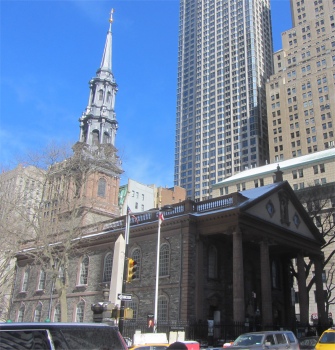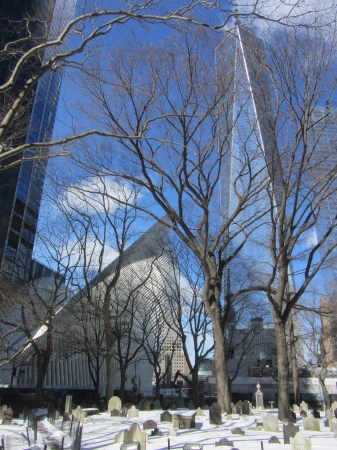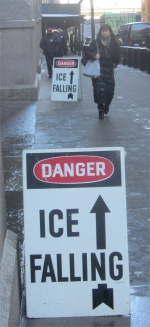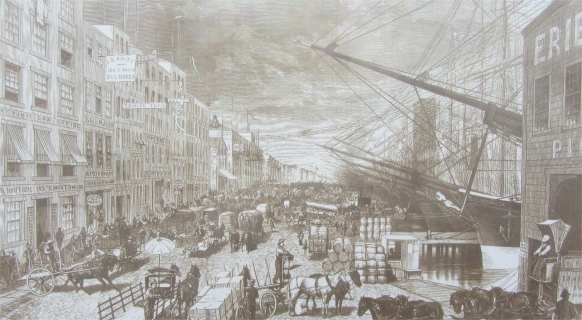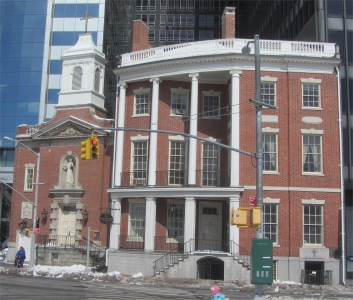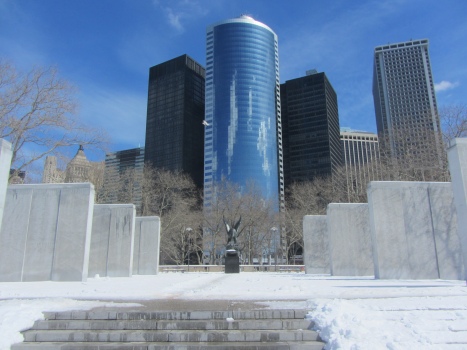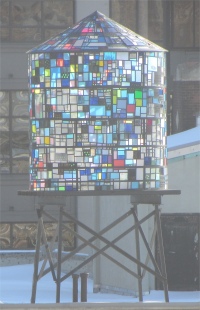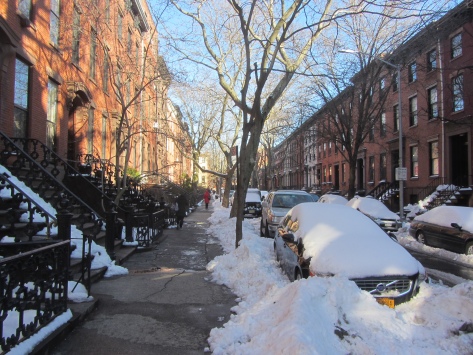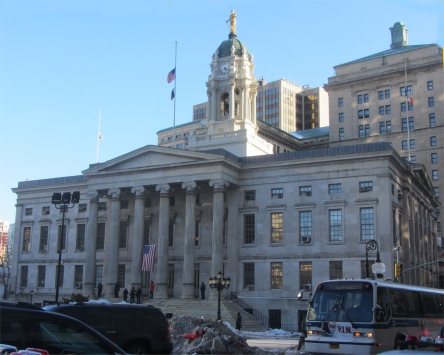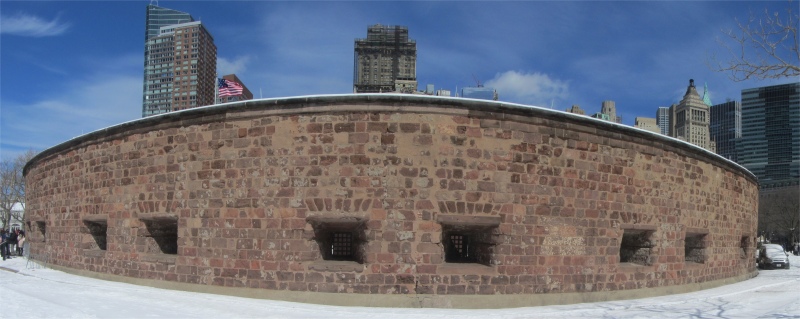
Castle Clinton
|
Over the years, both the land and the fortifications were enlarged. A prominent stone building in the park is Castle Clinton, built in anticipation of the War of 1812. The United States declared War on Great Britain on 12th June 1812. The declaration was the result of long simmering disputes. The central dispute surrounded the impressment of American soldiers by the British. The British attacked the
USS Chesapeake and nearly caused a war two years earlier. Additional, disputes continued with Great Britain over the Northwest Territories and the border with Canada. Attempts by Great Britain to impose a blockade on France during the Napoleonic Wars were also a constant source of conflict with the United States.
During the Battle of Bladensburg on 24th August 1814, the British marched into Washington, D.C., and burned most of the public buildings. President James Madison had to flee into the countryside. The British then turned to attack Baltimore but met stiffer resistance and were forced to retire after the American defence of Fort McHenry, which inspired Francis Scott Key to write the words of the "Star-Spangled Banner."
The war raged on for several more years until both sides were finally ready to negotiate a peace. The Treaty of Ghent was signed on 24th December 1814, but it took several months for the news to arrive back in the United States. The Battle of New Orleans took place on 8th January 1815, becoming the final major battle of the War of 1812.
By 1855, successive landfills had enlarged the park to encompass Castle Garden and the structure became America's first immigrant receiving center, welcoming 8.5 million people before the establishment of Ellis Island. The park is also home to many monuments and memorials, dating as far back as 1817 and including the Fort George Memorial, Netherlands Memorial, New York Korean War Veterans Memorial, East Coast Memorial and World Trade Center Sphere among others. The sphere stood in the WTC Plaza as a monument to world peace from 1971 to September 11, 2001.
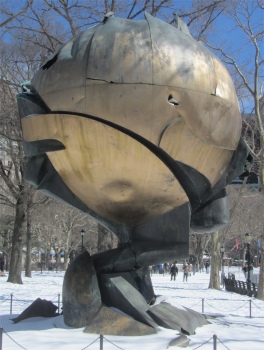
World Trade Center Sphere
|
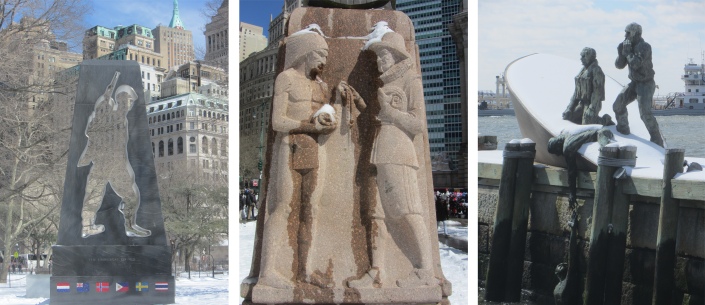
Other Battery Park Memorials
|
I tarried for a while around the park, taking photos. The virgin snow beneath my feet no longer crunched, it was so solid that no footprints were left behind.
Heading up Broadway, I passed the
Charging Bull. Today he was surrounded by hundreds of tourists who wanted photos of their entire group in every possible combination around the snorting creature. This curious multi-permutation/combination photo shoot seems to be a favourite of the Japanese.
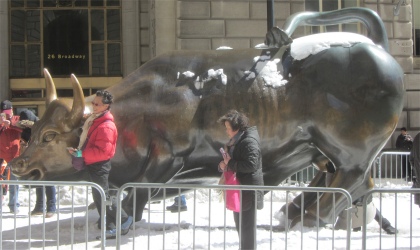
Charging Bull
|
At the junction with Wall Street stood Trinity Church. In 1697, a little over 70 years after the Dutch settled New York as a trading post, Trinity Church was granted a charter by King William III of England. Since then, Trinity has been an integral part of New York City. Today, Trinity Church and St. Paul's Chapel, just a few blocks north, are the cornerstones of Trinity Church Wall Street, a growing and vibrant Episcopal community. The present building is the third on the site, consecrated in 1846 and designed by British-born architect Richard Upjohn in the 19th century Gothic Revival style. The first church was lost in New York's Great Fire of 1776 and the second was demolished in 1839, at Upjohn's suggestion, after heavy snowfall revealed structural problems. The current building is a registered National Historic Landmark.
The steeple's 12 change-ringing bells are the only set in the United States; they rotate a full 360 degrees, producing a shimmering, cascading sound in a complex combination of changing tonal patterns. They can be heard on Sundays and special occasions.

Trinity Church
|

George Washington in Front of Federal Hall
|
I entered through the decorative bronze doors at the Broadway entrance. I marvelled at the stained glass, some of the oldest in the United States. It is a beautiful church. Strolling around the snow bedecked churchyard I came across graves dating from the 18th century, all serenely peaceful under their white blanket. A chap approached me and asked, "Do you know where Hamilton is?"
"Sorry, what or who is Hamilton?" was my inadequate answer.
"It's an important grave," he responded.
"You'd be better off asking one of the officials inside, they should have records," I advised. The man thanked me and moved on.
I later researched Alexander Hamilton. Hamilton, together with James Monroe, Henry Lee, John Marshall and Marquis de Lafayette were some of the Continental Army officers who served George Washington during the Revolutionary War. Of these rising stars, Hamilton overcame the greatest odds, including impoverishment and illegitimacy, in obtaining his position as aide-de-camp to General Washington. For approximately the next twenty years, Hamilton and Washington would work with each other during the Revolutionary War, the framing of the Constitution, and Washington's Presidency of the United States. The period of 1777-1778, however, pivotal to the success of the Continental Army, and ultimately that of the Continental Congress, also was important for Hamilton, for during this time, he rapidly proved his worth on a national basis. He rose to be the first secretary of the U.S. Treasury. He met his end in a duel with political rival, Aaron Burr, in 1804. So here was an important man in the U.S. history, and I had just shown my total ignorance about him.
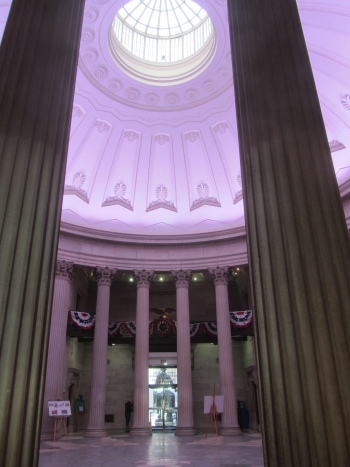
Inside Federal Hall
|
I enjoyed my moment of quiet in the midst of busy Lower Manhattan, and then headed down Wall Street. Major snow clearing operations involving diggers and trucks were in full force here. At the junction of Wall Street and Broad Street stood the Federal Hall. On 30th April 1789, this corner was awash in people. As a hush settled on the crowd, all eyes fixed on the tall man standing above them on the balcony. He was surrounded by officials of the new government of the U.S. and of the city and state of New York. The man was George Washington, and by now he was a living legend. His journey from Mount Vernon to this balcony had been one long parade, with town after town turning out to greet him with salutes, bands, and elaborate pageantry.
The building where Washington stood had been built in 1703 for the British royal governor's council and the assembly of New York. This was also New York City Hall, so prisoners were held and trials conducted here. After Britain's imposition of the Stamp Act in 1765, delegates of nine colonies met here to air grievances, declaring "no taxation without representation." In 1775 the revolutionary Provincial Assembly of New York took over use of the building. After the American Revolution this became the nation's capital when in 1785, the Congress under the Articles of Confederation sat here.
Many months of hard-fought ratifications of the new Constitution filled in the framework with laws and precedents. In addition to the Bill of Rights, Congress passed the Judiciary Act that established the coexistence of state and federal courts and laws. Some important precedents set were the Senate's role in diplomacy, Presidential control of cabinet appointments, and how the President should be addressed. The republic was launched.

New York Stock Exchange
|
The statue of George Washington by the balcony looked across to the New York Stock Exchange, which I visited about 30 years earlier. The present building opened in 1903. Behind its Neo-Classical facade lays the heart of the U.S. The exchange has grown from dealing with local businesses to a global enterprise.
On the opposite corner of this financial crossroads stands the J.P.Morgan Building. J. Pierpoint Morgan Senior, the capitalist's capitalist, known throughout the world of finance, sought out by presidents and potentates, helped bankroll the industrialisation of America. His influence was such that, during the financial Panic of 1907, he orchestrated everything from the rescue of trust companies to the bailout of the New York Stock Exchange.
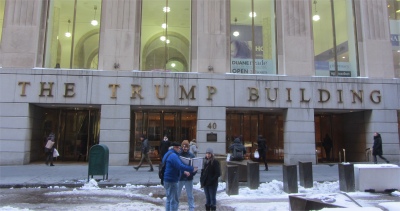
The Trump Building, 40 Wall St.
|
Continuing along Wall Street, my eyes were magnetically drawn to "The Trump Building" at 40 Wall Street. A large pink, granite building towered above me, and I simply could not resist entering - I'd soon find out if I was not welcome. Within a minute of entering I heard the inevitable, "Can I help you sir?"
I played the naive Brit, "Sorry, I saw the sign outside and I could not resist stepping inside. What goes on here?".
The stony face on one of the chaps at the desk, as hard and pink as the granite on the exterior of the building, relaxed and slowly melted into a smile, "If I told you, I would not be able to let you leave, sir."
"What, would Trump interrogate me personally?" I replied.
He discretely smiled again. "There are just offices and a little retail here," he answered. I didn't need to know more, so I thanked the guy and left. I can't say I would want to meet Mr Trump anyway.
Between Pearl and Water Streets on Wall Street, a market that auctioned enslaved people of African ancestry was established by a Common Council law on 30th November 1711. This slave market was in use until 1762. Slave owners wanting to hire out their enslaved workers, which included people of Native American ancestry, as day labourers, also had to do so at that location.
Slavery was introduced to Manhattan in 1626. By the mid-18th century approximately one in five people living in New York City was enslaved and almost half of Manhattan households included at least one slave. Although New York State abolished slavery in 1827, complete abolition came only in 1841.

Views Along South Street
|
Wall Street was brought to an abrupt end at South Street. I strolled up it this time, passing a large bar that was holding a private function. The hordes inside sounded as though they were having a whale of a time. A short distance further on I miraculously escaped a thundering avalanche as it poured off a roof.
